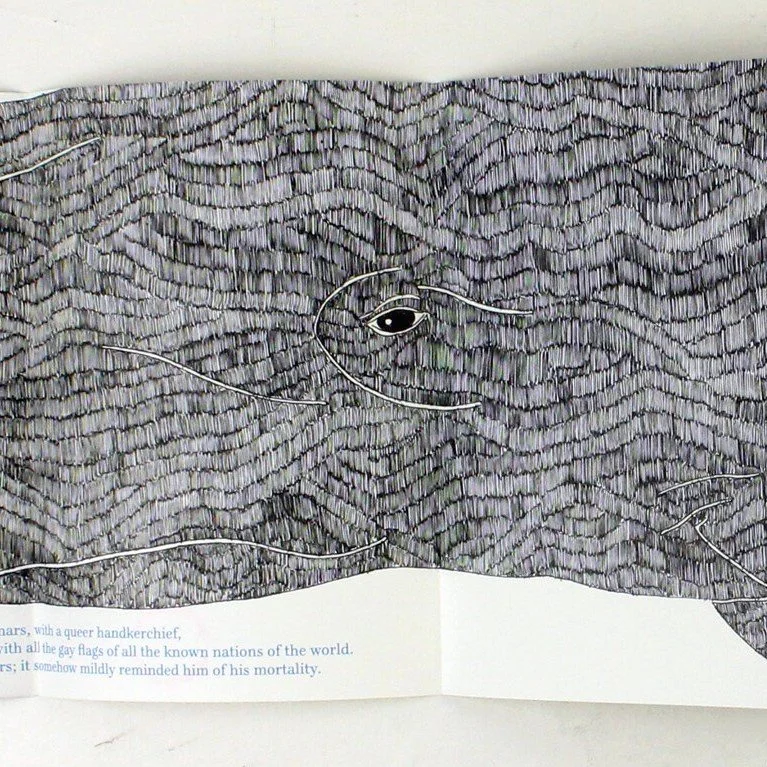The Peabody Essex Museum’s exhibition Draw Me Ishmael: The Book Arts of Moby Dick opened on June 1st, 2024, and will be on display until March 29, 2026. The exhibition features more than 50 uniquely illustrated artworks from various editions of the novel Moby Dick by Herman Melville. From book covers to page illustrations, the artworks on display range in style and approach to celebrate the diversity in the interpretations of the beloved novel.
The exhibit is displayed in a rectangular room, with the book and illustrations on the walls and in cases that follow the walls. In the center of the room are another half-wall and cases with more work. The setup creates a circular flow around the room, allowing the viewer to continue circulating it again and again. The works switch between covers, pages displayed open to different illustrations and texts, and even some works displayed on the wall to exhibit both the front and back covers. Dispersed among these were other framed illustrations on the wall. Depending on which door you open or exit through, you will also be met with a seated section that features a rowboat turned book-nook corner where you can read mass-produced variants of the novel or just sit and reflect on the exhibit.
The interaction between the viewer and the artwork in this exhibition adds an interesting dynamic to the experience. The collection is placed in a fairly claustrophobic space, with the artworks displayed in positions that aren’t necessarily conducive to the works. This, coupled with the circular flow, seems to reflect the circular nature of the novel. Much like Captain Ahab, who is constantly chasing the white whale, the viewer is forced to continuously circle the room to fully take in every piece due to the limited space and placement of the books and artworks. The works range from the title page from Mead Schaeffer’s illustrated edition with naturalistic renderings to more blocky and stylized woodcut illustrations. Non-traditional approaches to illustration included Moussa Kone’s Etymology (Moby Dick Filet no. A), which was created for the introductory chapter of an edition of Moby Dick, which, when completed, will feature every chapter reimaged by a different artist. The unfolded accordion book format artwork features the famous sperm whale stylized through a series of black and white hatches and lines. These, among others, exhibit the various ways artists, since the 1850s until now, have all attempted to take the text and create an image representing a scene or concept. For example, Bill Sienkiewicz’s 1990 graphic novel edition depicts the story's events with psychological horror imagery.
Billy O’Callaghan, mcmfmd* *more choice morsels from moby dick
Not all works are illustrations; some works, such as that of artist Billy O’Callaghan, are artbooks inspired by the text. His book, mcmfmd (or, more choice morsels from moby dick) is a artist's book that takes experts of Moby Dick and removes them from their original context and crudely pastes them on shirts and hats in Comic Sans, this creating a book that documents disjointed lines and phrases that sound queer in their new context (such as a shirt that says pale lime green shirt that simple states “sage ejaculations.”) Works like these, rather than attempting to translate the text into an image, create a new work entirely. It is still derivative, like an illustration, but the goal is not to translate words into an image but rather to transform the text. Another work that stands out is Emma Tomblin Marca’s Whale (2020), which is an abstract artist’s book with pop-up illustrations. This piece features hues of blue applied in a painterly fashion with abstract shapes constructed out of paper that pop out at the viewer. With a lack of text or easily identifiable shapes, this artwork encourages viewers to explore this work uniquely.
These artworks collectively create a fascinating dialogue about the nature of illustration and the legacy of a beloved classic. It’s such a shame, though I don’t think the allocated space gives the artworks enough room to breathe. Due to the nature of the room’s flow and how the books and art are displayed, it is difficult to enjoy the work. It artworks feel crammed. While I believe this is intentional and reflects aspects of the novel, I am not entirely convinced it suits the works perfectly. Instead, I feel it takes away from the artworks at times. The collection of books and which illustrations were chosen for display are engaging on their own, and the curatorial decision to display which works together was well throughout and thought-provoking at times. The show, as a collection of works, is powerful and impactful on their own. However, the space itself was stifling. The exhibit accomplishes the goal of engaging the viewer into thinking untraditionally and independently about Moby Dick; it is impossible not to gain a new perspective on the novel after exploring the varying ways artists have transformed the text into art. But every time I think about a piece I enjoyed or a work that fascinated me, I also am forced to remember how the space limited the ways I could engage.
Check out this exhibition before it closes.

